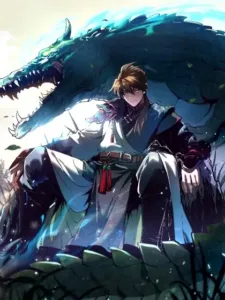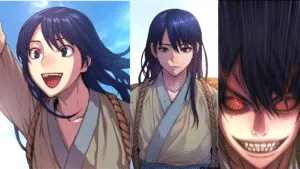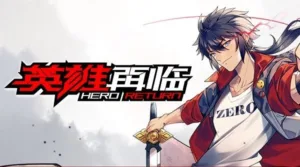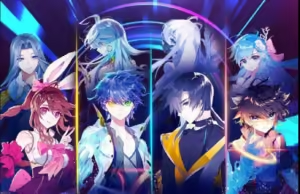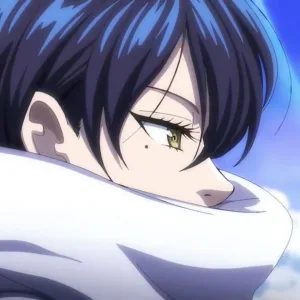Rebuild World is a cyberpunk/post-apocalyptic manga adapted from a web novel/light novel written by Nahuse. The story follows the struggle for survival in a post-catastrophe future, blending action, technology, and dungeon crawler elements within a richly detailed universe. In this review, we explore the key aspects of the work — from plot and setting to characters, artwork, comparisons with the original novel, and public reception — in a way that's accessible to both new readers and fans of the original story.
Story and Setting
The story takes place decades after an unknown cataclysm devastated civilization, leaving behind only the ruins of a highly advanced “Old World..
Most of humanity lives in harsh conditions, confined to corporate city-states surrounded by vast post-apocalyptic wastelands, while only the wealthiest enjoy comforts such as real food.
In this desolate setting, Hunters emerge — individuals who explore the ruins in search of lost technological relics, valuable enough to make someone rich… that is, if they aren’t killed first by robotic sentinels or mutant creatures, the remaining biological and mechanical remnants of the collapse.
Akira, the protagonist, is a young orphan from the slums who decides to become a Hunter to escape a life of poverty. On his first expedition into the ruins, he nearly meets his end but is saved by Alpha, a mysterious artificial intelligence that only he can see and hear through augmented reality.
Alpha has her own goals — to explore a dangerous area within the ruins — and proposes to train and guide Akira in exchange for his help with her missions. This marks the beginning of a unique partnership, in which Akira ventures into technological dungeons in search of artifacts, facing deadly monsters and security systems, then returns to the city to sell his finds, upgrade his gear, and prepare for ever greater challenges.
The tone of the narrative balances raw survival with high technology. Unlike many fantasy or isekai stories, Rebuild World doesn’t offer “magical tricks” or powers freely granted to the hero — survival truly belongs to the fittest, relying on firearms, tech gadgets, strategy, and courage in a ruthless world. Throughout the chapters, Akira faces not only creatures and robots from the Old World, but also the inequalities of his own society (where powerful corporations control resources and information) and the mysteries behind civilization’s collapse. The core themes include class struggle (the rich vs. the poor in the outer districts), the use of ancient technology to rebuild society, and trust between man and machine — embodied in the alliance between Akira and the enigmatic Alpha. The cyberpunk/post-apocalyptic setting is filled with dangerous locations (ruined cities, underground facilities) and futuristic equipment (combat suits, cybernetic implants, vehicles, and advanced weaponry), creating a world that has regressed in quality of life but still retains elements of advanced science fiction. This duality gives the work a unique charm, blending RPG-style dungeon exploration with dystopian science fiction.
Characters
The characters in Rebuild World are crafted to reflect the harshness and complexity of the world they inhabit. Akira begins the story as a starving boy with no formal education, shaped by a lonely childhood and constant betrayals that left him distrustful and even emotionally numb toward others. He has developed a hardened personality — capable of acts of compassion or extreme coldness depending on what he deems necessary — and mentally divides people into two groups: those he can trust (a rare few) and “everyone else.” At first, Akira only cares about surviving at any cost, strictly honoring deals even if it means eliminating those who stand in his way. However, as the story progresses and he encounters genuine allies (such as Alpha and a few others who offer him kindness), Akira begins to mature and rethink his actions. Thanks to these relationships — especially with Shizuka, a shop owner, and other girls who grow close to him — he gradually restrains his violent impulses and starts to consider the consequences of his choices, though he does not hesitate to kill in self-defense. This arc of personal growth makes Akira a more complex protagonist than the typical “flawless hero”: he makes mistakes, learns, and evolves — retaining dark traits (like his lack of remorse when eliminating enemies) while slowly discovering a sense of responsibility toward the few people he truly values.
Alpha, in turn, is a character as intriguing as she is essential. As an augmented reality-based artificial intelligence, she appears only to Akira in the form of a young and beautiful woman with long blonde hair and a futuristic outfit. Alpha serves as Akira’s mentor and partner — providing tactical analysis, calculating escape routes, training his combat skills, and even supplying knowledge and equipment to aid him. However, her true goals remain partially hidden: it’s only known that she needs a human to explore areas where she cannot go due to lacking a physical body. The dynamic between Akira and Alpha blends growing trust with a touch of suspense, as both the reader and Akira are left wondering about the AI’s ultimate motivations. Despite being a digital entity, Alpha displays a charismatic and even humorous personality, occasionally teasing Akira with suggestive remarks. One example is the comic relief/fanservice scenes in which Alpha jokingly asks the boy whether he prefers her to appear “with or without clothes” — something rather awkward, considering Akira is still practically a child at the beginning. These provocations serve both to spice up the mentor-student relationship and to remind the reader that Alpha, though helpful and friendly, operates according to her own logic and retains an air of mystery.
Beyond the main duo, Rebuild World features a cast of memorable supporting characters that enrich the narrative. Sheryl, for example, is a slum girl who crosses paths with Akira and ends up under his protection. Initially a reluctant leader of a small group of homeless people, Sheryl shows cunning and a strong desire to change her life, becoming Akira’s ally in pursuit of a better future beyond poverty. Their relationship evolves from one of convenience to something closer to friendship and mutual trust — Sheryl begins managing information and resources for Akira, while he offers her safety in return. There are also veteran Hunters Elena and Sara, an experienced duo who serve as a glimpse of what Akira might one day become. They are introduced early in the story when they rescue Akira from danger and later reappear offering him tips and assistance. With distinct personalities (Elena is kind and protective, while Sara is more blunt and battle-loving), they both illustrate the realities of being a high-level Hunter, emphasizing camaraderie and the risks of expeditions. Characters like these expand the scope of the world — offering different perspectives on survival — and help Akira realize that trust and cooperation can be just as vital as skill with weapons. Even figures like Katsuragi (a weapons and parts dealer, opportunistic but reliable within certain limits) and Shizuka (owner of a shop/café that caters to Hunters, acting almost like an older sister to Akira) contribute to giving the story emotional depth. In short, Rebuild World builds a cast where every character — main or supporting — has clear motivations and evolves with the events, reflecting the moral and practical challenges of living in a world rebuilt on ruins.
Art and Visual Style
The Rebuild World manga stands out for its detailed and impactful artwork by Kirihito Ayamura, who visually conveys the full complexity of the novel’s universe. The illustration quality is one of the work’s highlights — it has even been praised by Brazilian fans as “bonita pra caralho” (extremely beautiful). The panels are rich in detail, both in the devastated urban landscapes and in the futuristic elements, ensuring an immersive atmosphere. There is clear attention to depicting the ruins of the Old World: half-destroyed buildings, abandoned machines, and vast desert landscapes are drawn with expressive shading and fine lines, giving the reader a sense of a hostile place filled with technological secrets. At the same time, the technological designs — such as firearms, armor, drones, and biomechanical creatures — show great complexity and creativity, the result of collaboration with the original novel's designers (the adaptation uses world design by Waishu and mechanical design by “cell” as reference). This visual fidelity to the source material means that novel readers will immediately recognize equipment and environments, while newcomers will be impressed by the manga’s aesthetic coherence.
The art style balances the dark realism typical of a seinen with the dynamic clarity of an action shōnen. Combat scenes, for example, are fluid and easy to follow, using cinematic framing and speed effects to bring gunfights and monster battles to life. Kirihito Ayamura skillfully conveys the tension of these encounters — explosions, bullets slicing through the air, and tactical maneuvers guided by Alpha — without losing the reader in visual confusion. The character designs also deserve recognition: Akira is drawn in a way that reflects his youth and ferocity — a determined gaze, scars, and the worn-out clothes of a slum boy, which gradually evolve as he acquires better gear. Alpha, by contrast, has an almost ethereal and high-tech appearance — form-fitting suits, a luminous projection around her body, and a confident posture. This visual duality emphasizes the contrast between Akira’s harsh, material world and Alpha’s advanced, intangible nature. Other characters are designed in line with their backgrounds — Sheryl, for example, is initially shown in the simple, dirty clothing of someone living in the slums, while seasoned Hunters like Elena and Sara wear robust and stylish gear, showcasing their experience.
One important point to note is that the manga does not hold back in portraying the violence and harshness of the rebuilt world. The illustrations graphically depict blood, injuries, and destruction when necessary, reinforcing the dangerous atmosphere. On the other hand, there are also lighter visual moments, especially in Akira’s interactions with Alpha. The artist often draws her in a seductive or comedic way, taking advantage of her holographic nature — Alpha might suddenly appear miniaturized, sitting on Akira’s shoulder, or project herself at full size in provocative poses, as only he can see this technological “ghost.” These aesthetic choices bring visual relief amid the devastated scenery and also serve as moderate fanservice. All in all, the artwork in Rebuild World does an excellent job of bringing the series’ futuristic post-apocalyptic setting to life. Each manga chapter delivers a visual spectacle that enhances the narrative: from vast desolate horizons to fast-paced, effect-laden battles, everything is presented with clarity and artistic dedication. For readers of the original novel, the manga adaptation offers a faithful and thrilling representation of what once lived only in the imagination; for new fans, it serves as an irresistible invitation to dive into a world full of action and mystery.
Comparison with the original novel
The Rebuild World manga stands out for its detailed and impactful artwork by Kirihito Ayamura, who visually conveys the full complexity of the novel’s universe. The illustration quality is one of the work’s highlights — it has even been praised by Brazilian fans as “bonita pra caralho” (extremely beautiful). The panels are rich in detail, both in the devastated urban landscapes and in the futuristic elements, ensuring an immersive atmosphere. There is clear attention to depicting the ruins of the Old World: half-destroyed buildings, abandoned machines, and vast desert landscapes are drawn with expressive shading and fine lines, giving the reader a sense of a hostile place filled with technological secrets. At the same time, the technological designs — such as firearms, armor, drones, and biomechanical creatures — show great complexity and creativity, the result of collaboration with the original novel's designers (the adaptation uses world design by Waishu and mechanical design by “cell” as reference). This visual fidelity to the source material means that novel readers will immediately recognize equipment and environments, while newcomers will be impressed by the manga’s aesthetic coherence.
The art style balances the dark realism typical of a seinen with the dynamic clarity of an action shōnen. Combat scenes, for example, are fluid and easy to follow, using cinematic framing and speed effects to bring gunfights and monster battles to life. Kirihito Ayamura skillfully conveys the tension of these encounters — explosions, bullets slicing through the air, and tactical maneuvers guided by Alpha — without losing the reader in visual confusion. The character designs also deserve recognition: Akira is drawn in a way that reflects his youth and ferocity — a determined gaze, scars, and the worn-out clothes of a slum boy, which gradually evolve as he acquires better gear. Alpha, by contrast, has an almost ethereal and high-tech appearance — form-fitting suits, a luminous projection around her body, and a confident posture. This visual duality emphasizes the contrast between Akira’s harsh, material world and Alpha’s advanced, intangible nature. Other characters are designed in line with their backgrounds — Sheryl, for example, is initially shown in the simple, dirty clothing of someone living in the slums, while seasoned Hunters like Elena and Sara wear robust and stylish gear, showcasing their experience.
One important point to note is that the manga does not hold back in portraying the violence and harshness of the rebuilt world. The illustrations graphically depict blood, injuries, and destruction when necessary, reinforcing the dangerous atmosphere. On the other hand, there are also lighter visual moments, especially in Akira’s interactions with Alpha. The artist often draws her in a seductive or comedic way, taking advantage of her holographic nature — Alpha might suddenly appear miniaturized, sitting on Akira’s shoulder, or project herself at full size in provocative poses, as only he can see this technological “ghost.” These aesthetic choices bring visual relief amid the devastated scenery and also serve as moderate fanservice. All in all, the artwork in Rebuild World does an excellent job of bringing the series’ futuristic post-apocalyptic setting to life. Each manga chapter delivers a visual spectacle that enhances the narrative: from vast desolate horizons to fast-paced, effect-laden battles, everything is presented with clarity and artistic dedication. For readers of the original novel, the manga adaptation offers a faithful and thrilling representation of what once lived only in the imagination; for new fans, it serves as an irresistible invitation to dive into a world full of action and mystery.
Public reception and impact
Since its release, Rebuild World has been steadily gaining a positive and growing reception both in Japan and internationally, establishing itself as a standout work in its genre. The original light novel quickly caught attention, ranking 5th place in the 2020 edition of the Kono Light Novel ga Sugoi! guide — a respected publication listing the best light novels of the year. This early recognition indicated strong support from Japanese readers right from the first volumes. As new volumes were released, sales remained solid — by July 2023, the series had over 750,000 copies in circulation across all editions, a significant number for a relatively recent light novel franchise. The domestic success culminated in the announcement of a Rebuild World anime adaptation, officially revealed by ASCII Media Works/Kadokawa, which generated a wave of excitement within the otaku community. After all, receiving an anime adaptation often signals that a series has reached a certain level of popularity and holds the potential to reach an even broader audience.
In the West, Rebuild World is still considered by some to be an “underrated” or “hidden gem”, as it hasn't received the same widespread promotion as other isekai or cyberpunk titles (at least not yet, until the anime premieres). However, among fans of post-apocalyptic light novels and manga, the series has earned a strong reputation. Readers praise its blend of elements — action, well-crafted worldbuilding, a compelling protagonist, and high-quality artwork — which makes for an engaging experience. On forums and social media, there are comments calling Rebuild World “seriously underrated,” pointing out that the manga features excellent artwork and a story that may even surpass the novel’s, which is a rare achievement in adaptations.
This assessment suggests that, for many, the manga adaptation has elevated the original material — whether through pacing or visual impact — while preserving the best aspects of the novel. Reviews on specialized websites and online stores tend to reflect this satisfaction: the manga volumes often receive high ratings (4 or 5 stars) and positive comments that highlight the depth of the plot and the emotional connection to the characters.
Within the cyberpunk/post-apocalyptic genre, Rebuild World occupies an interesting niche. It’s often recommended to those looking for an alternative to the typical isekai clichés with “overpowered heroes,” as it offers a more realistic and unforgiving setting, without easy magic. Comparisons have been made to works like Made in Abyss or Tsutomu Nihei’s Blame! in terms of exploring a mysterious technological world, and even to Fallout (the video game series) due to its artifact-filled wasteland vibe. However, Rebuild World carves out its own identity by blending RPG-style progression (missions, loot, upgrades) with a story centered on the personal growth of a marginalized survivor. This unique approach has been recognized by readers, giving the series a lasting impact — many eagerly await the next manga chapters or novel volumes, actively discussing theories about Alpha and the Old World.
The positive reception is also reflected in the dedicated fan community — the subreddit r/RebuildWorld, for example, has been steadily growing, hosting discussions from longtime fans of the original web novel, who have been following the series since 2017, to new readers who discovered it through the manga and then transitioned to the novels in search of more content. This synergy between mediums has helped expand the fanbase: those who discover the manga often go on to read the licensed light novel (with J-Novel Club publishing the digital English version, making the content accessible outside Japan), and vice versa. With the anime currently in production, the series is expected to see an even greater surge in popularity — potentially bringing Rebuild World into the global spotlight of the post-apocalyptic cyberpunk genre.
In summary, the impact of Rebuild World is evident in the strong approval it has received from its niche audience so far, as well as in its potential to become a flagship franchise within the genre. The manga, in particular, has successfully expanded the story's reach with high quality, winning over readers who prefer comics and earning praise for doing so. Now, it's a matter of following the next steps — new volumes, adaptations, and ongoing discussions — but the solid foundation built so far suggests that Rebuild World is here to stay in the minds of fans of a good post-apocalyptic sci-fi adventure.
Rebuild World offers a robust experience that combines a richly detailed post-apocalyptic world, evolving characters, and well-paced action, all brought to life through stunning artwork. Whether through the manga or the original novel, the series stands out within its genre, delivering a dark yet thrilling vision of a future where rebuilding the world means confronting the ghosts (and machines) of the past. For those who enjoy cyberpunk, survival, and a healthy dose of technological mystery, this saga is definitely worth the read — and it continues to rebuild and surprise with each new chapter.

